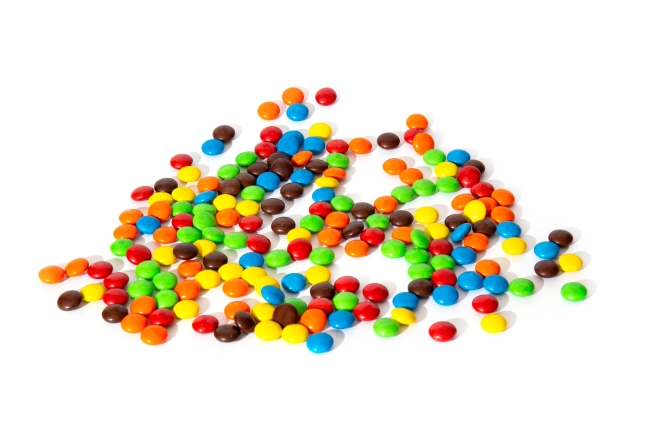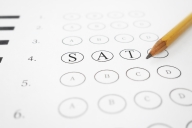You have /5 articles left.
Sign up for a free account or log in.

Nantawit Chuchue/iStock/Getty Images Plus
The first day of class, especially if it’s the first day of college for first-year students, is one of possibility smothered by anxiety. Every professor knows this. The students are excited but nervous. They rarely talk to each other—more often they are locked into their own heads via earbuds and smartphones. Some are hoping for a syllabus day; others are dreading a syllabus day, already intimidated by the amount of work and policies set out in that mighty tome.
Every professor also knows the importance of this first day, how it sets the tone for the entire semester. But finding a way to engage students in a comforting yet intellectually stimulating manner is a continuing challenge. For almost 15 years, I’ve had a lot of success with an activity designed to fail: an activity involving flying candy. I throw M&Ms at the students, or, more accurately, at small paper cups resting on their desks. They brighten, pay attention and laugh as I hurl candy-coated chocolates across the room, missing the tiny cups every time.
The activity is fun and breaks the tension, but it also does so much more. At the end of the initial barrage, I tell them their goal is to get as many M&Ms into their individual cups as possible. Everyone agrees my approach of tossing candy at stationary cups from across the room is not a winning strategy. I ask for suggestions on a better approach.
Someone always suggests holding the cup to try to catch the candies. We give it a try. It rarely works. The candies bounce out, even if we manage to connect candy with cup. Someone else always suggests I walk around the room distributing the candy. I respond it’s a good idea, but too much exercise for me. Then someone, sometimes brimming with confidence, hand raised in the air Hermione Granger–style, other times with shyness, hand partially up, sheepishly asks, “Can I come and take the M&Ms myself?”
I smile and ask the students if that would be an effective way to get M&Ms. Everyone agrees. I encourage the student to come on up and take what is theirs. After the student returns to their seat with a cup of calories, I inquire about the purpose of this exercise, other than to have a fun and memorable first day of class.
Sometimes silence. Sometimes a few hands in the air. Most often, the students are not prepared to consider the deeper meaning of candy zipping past their heads, missing the intended target in utter failure. They are not expecting figurative language in an introductory biology class, but they unknowingly are primed for an analogy on learning.
I explain the M&Ms represent discrete bits of information called facts. The cup is their brain. I could throw a fact at them: “Carbon dioxide has low potential energy.” It misses their brain. I sling another bit: “Oxygen has high electronegativity.” It sails past their cup, passive and empty. Time and time again, the metaphorical fact misses their metaphorical brain. They need to realize learning is an active process. All the world’s information is at their disposal; they just need to get up and take it. They can’t expect to learn if they consider themselves empty vessels waiting to be filled by the sage on the stage. It takes work on their part.
Conversely, I can’t expect them to learn if I treat them as empty vessels, each the same size and shape—yes, subtle inclusivity reference—waiting passively to be filled. It takes work on my part to help them fill their metaphorical cup. It’s an important lesson for them, yet it’s also a reminder for me to engage, not lecture.
I continue the analogy. If M&Ms represent facts, then of what good is a collection of them? What can they do with this cup of M&Ms? Someone says, “Eat them.” I agree but then ask how they could be eaten. By themselves, in cookie batter, spread as a topping on ice cream, crushed and sprinkled on brownies. Or don’t eat them at all but use them as raw material for an art project. Each of us could come up with different ways to use the M&Ms to create something new, something wonderful, from those otherwise individual candies.
I then suggest—no, plead—for them not to think of their education as the simple collection of information, but to consider how this information can be used and how it relates to other topics. This conversation then leads into an introduction of Bloom’s taxonomy, which is new to most students. I ask them to consider our fact “carbon dioxide has low potential energy.” The fact isn’t particularly useful unto itself. It’s meaningless without an understanding of potential energy and bonding between carbon and oxygen. And then we can consider the importance of this fact to biological processes and to climate change. I end by commenting if any of them can create a new way to effectively capture and store carbon dioxide, they could make a fortune. They are primed to learn that each fact is connected to a universe of other information, that making those connections is the essence of learning.
As the class nears its end, we as students and professor come to an explicit agreement not to treat ourselves and each other as empty vessels waiting to be filled. We will engage with each other and be active in our learning. And when the class in fact ends, I invite each student to come up and help themselves to M&Ms—or to Skittles for those who either prefer or need a nonchocolate, nondairy alternative. Yes, another nod to inclusivity.
My hope is that students leave the class a little less nervous and possibly even excited about what is before them. I hope they leave inspired to be active in their education and strive to do more than collect facts, more than memorize.
And my hope is usually rewarded. I love it when seniors, often with one hand reaching for their diploma, tell me they distinctly remember that first day of class, of college, of the lesson of the flying candies. Or when I hear alumni who are visiting for homecoming reminiscing with their spouse or significant other about that first lesson and how they realized, as they dodged projectile candies, that learning is more than collecting and they are more than a vessel to be filled.
On those occasions, I wish I had a stash of candy to disperse to reward them for a job well done. But then, their long-term reward is much greater than anything I could bestow, even with candy-coated chocolate perfection. Starting a semester or a college career with a lesson hidden in thrown candy missing its mark is a meaningful way, in any course, to connect to nervous students. And all it takes is a bag of M&Ms, a few inexpensive paper cups, a little performance bravery, a discipline-appropriate fact and the willingness to clean a floor littered with dirty, but certainly not wasted, candy.








